The first thing that usually pops into your mind when you hear the name “Hawaii” is the magical beaches with their mystical colors. It’s the home of surfing and one of the world’s top vacation destinations, but it’s also a great place to watch different birds.
With its multiple habitats, Hawaii is home to 337 bird species, including 64 endemic birds. Although 33 of these special species went extinct, you can still watch Hawaiian birds near water bodies or in its various national parks and amazing forests. In addition, the island of Kauai has a wonderful bird sanctuary that you must visit.
In this article, we’ll highlight some of the most amazing birds you can witness in Hawaii. Hawaiian bird photography presents some amazing opportunities for the diligent shutterbug. So, get out your bird books and keep on reading to learn more about these fantastic creatures.
Red Birds in Hawaii
Red-Crested Cardinal
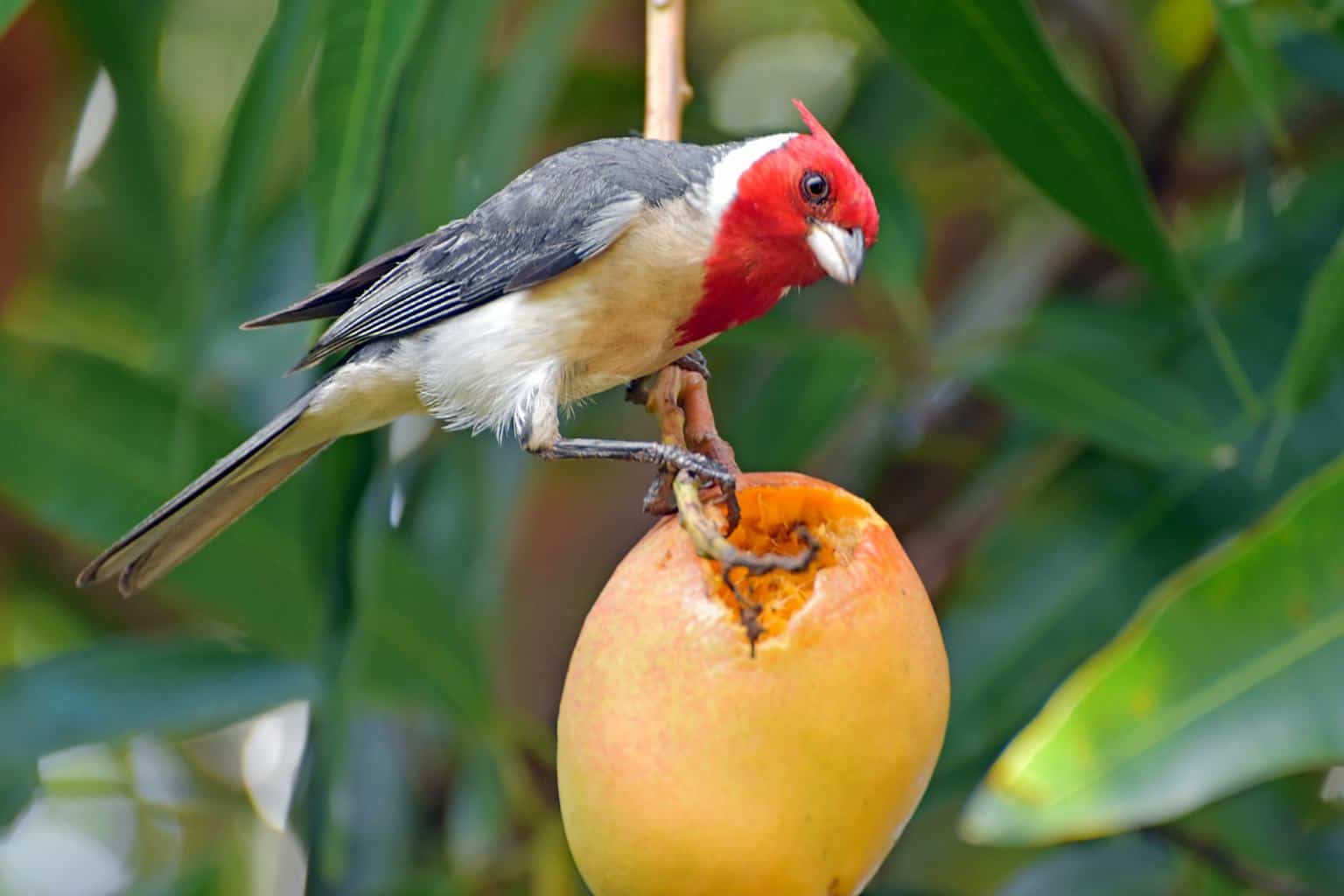
- Scientific Name: Paroaria coronata
- Length: About 7.5 inches
- Weight: About 1.55 ounces
- Wingspan: Between 10.5 and 11.5 inches
This small songbird is known for its overall gray body and bright red crest that make it easy to identify. It’s native to Brazil and is not actually related to the true Cardinal family. You can find the Red-Crested Cardinal in the lowlands of the main Hawaiian islands.
This bird is diurnal and can usually be found in pairs or small groups. It has a short yet melodious song and feeds on berries, seeds, and insects. You can attract it to your bird feeder by filling it with black oil sunflower seeds and berries.
ʻIʻiwi
- Scientific Name: Drepanis coccinea
- Length: About 6 inches
- Weight: About 0.5 ounces
- Wingspan: Between 5 and 6 inches
The ‘I’iwi, also known as the Scarlet Hawaiian Honeycreeper, is one of Hawaii’s most sought-after wild birds. These birds are bright scarlet with black wings and curved bills that allow them to sip on nectar. It occasionally feeds on small arthropods.
According to the Hawaiian legend, the demi-god Maui loved this attractive bird. These aggressive birds are loud and violent towards other species near nectar sources. The ‘I’iwi can be found in forests above 4000 feet in Kauai, Maui, and the Big Island.
This bird is currently listed as threatened, mainly because of avian malaria. Land development projects have also affected the bird’s habitat, so they can be challenging birds to spot.
Northern Cardinal

- Scientific Name: Cardinalis cardinalis
- Length: Between 8.3 and 9.1 inches
- Weight: Between 1.9 and 2.29 ounces
- Wingspan: Between 9.8 and 12.2 inches
Compared to other songbirds, the Northern Cardinal is rather big. It has an overall red body with some black feathers surrounding the bill. Female birds are pale brown but have bright red crests and accents. This bird was introduced in Hawaii in 1929.
It can now be found on all Southeastern Hawaiian Islands. Male cardinals are highly territorial and attack their reflections in glass windows. Birds feed on seeds, fruit, and insects and will be attracted to your backyard if you set up a platform feeder.
ʻApapane
- Scientific Name: Himatione sanguinea
- Length: About 5.1 inches
- Weight: Between 0.51 and 0.56 ounces
- Wingspan: Between 5 and 5.5 inches
The ‘Apapane is a widespread forest bird that can be found in Hawaii. Male birds are slightly larger than females, and both have bright crimson bodies.
This bird breeds above 3,000 feet in the forests of the major islands and is one of the few Hawaiian Honeycreepers not threatened by extinction. It’s an active singer, and each song can last between 10 and 30 seconds.
It has a brush-tipped tongue that it uses to feed on the nectar of the ʻōhiʻa lehua trees and other flowering plants. It’s a good pollinator, and its face is usually covered in pollen. It also feeds on insects like moths, grasshoppers, butterflies, and spiders.
Red Avadavat

- Scientific Name: Amandava amandava
- Length: About 4 inches
- Weight: About 0.25 ounces
- Wingspan: Between 4.5 and 5.5 inches
The Red Avadavat, also known as the Strawberry Finch, has a bright red body with white or brown spots. Female and non-breeding males have duller plumage. The male usually collects the material for the nest, and the female builds it.
This tiny bird became a popular cage bird at the beginning of the 20th century. It can be found in marshy areas or near water bodies. It’s a ground feeder and feeds on grass seeds, but it can also eat termites, ant pupae, and fruit flies when they’re available.
Red-Footed Booby
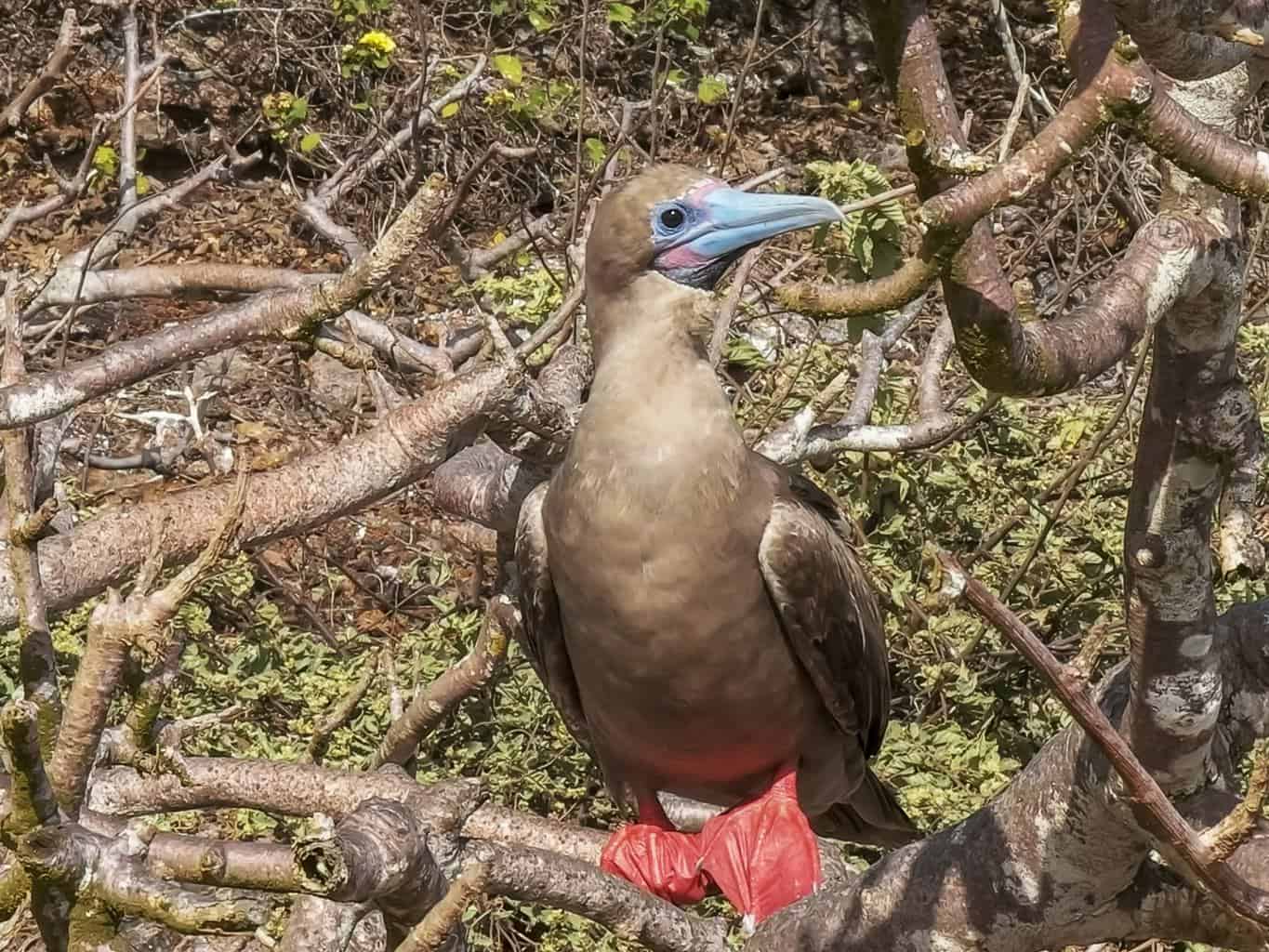
- Scientific Name: Sula sula
- Length: Between 27.2 and 31.1 inches
- Weight: Between 30 and 38.8 ounces
- Wingspan: About 60 inches
This large waterbird has a white body with black feathers along the back edge of the wing. It’s known for its bright red feet and pink-blue bill, and throat pouch.
The Red-Footed Booby is indigenous to Hawaii, where it spends most of its time feeding at sea. It nests in colonies near coastal trees and shrubs, building open platforms of twigs, grass, and leaves.
This bird feeds mainly on flying fish and squid. It never flies while catching its prey but swallows it first. The birds don’t migrate and can often be seen landing on marine crafts.
Redhead
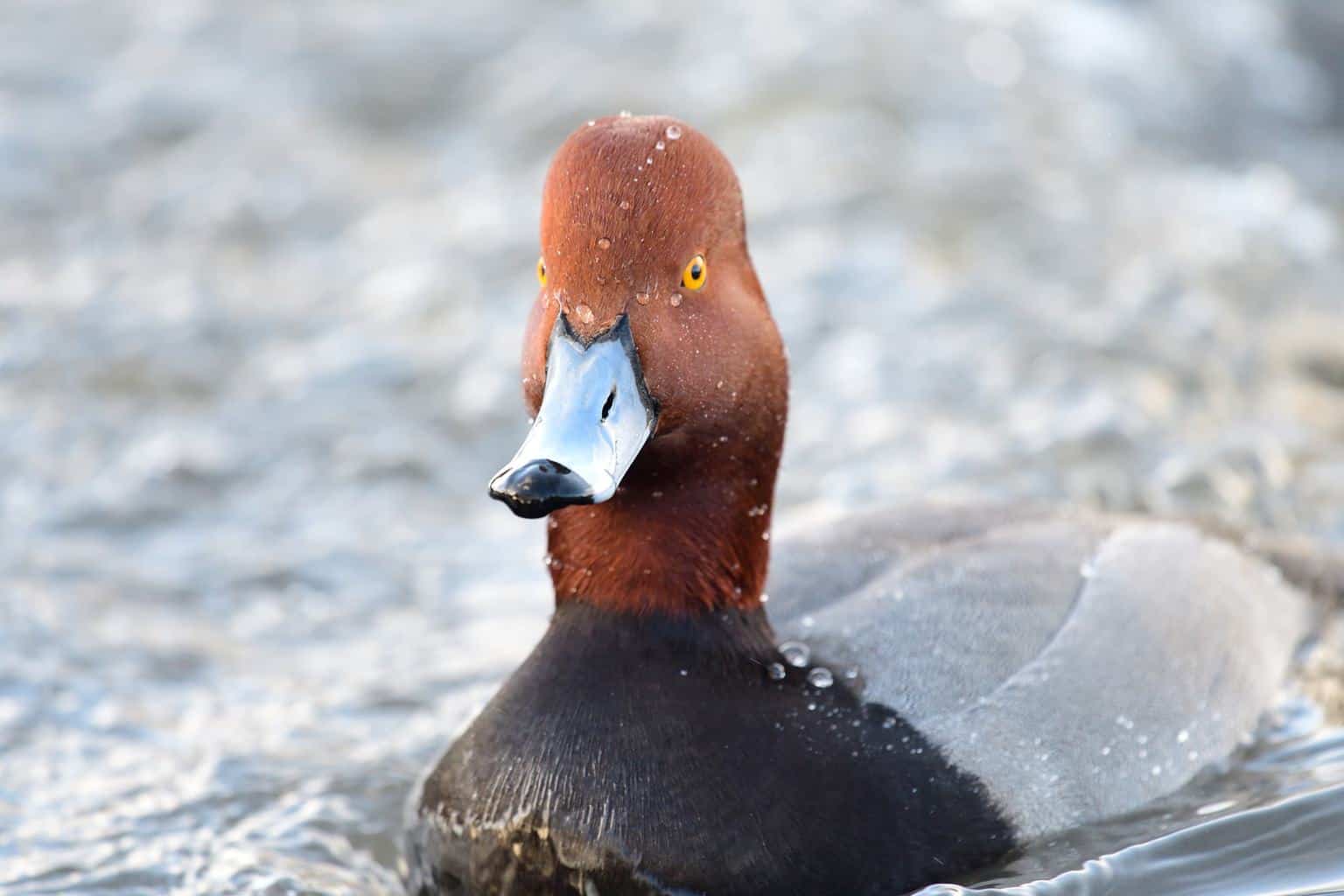
- Scientific Name: Aythya americana
- Length: Between 16.5 and 21.3 inches
- Weight: Between 22.2 and 52.9 ounces
- Wingspan: Between 29.5 and 31.1 inches
Male Redheads are larger than females and have cinnamon heads, black breasts, and black tails, while females and immature birds are usually brown. The male birds are known to throw their heads back while bending their necks to attract the females.
The Redhead can be found around marshes, where it feeds on plants and algae, in addition to invertebrates. Owls and hawks attack this bird while crows steal the eggs. Female birds lay their eggs in the nests of other birds when water levels are low.
Blue Birds in Hawaii
Blue-Winged Teal
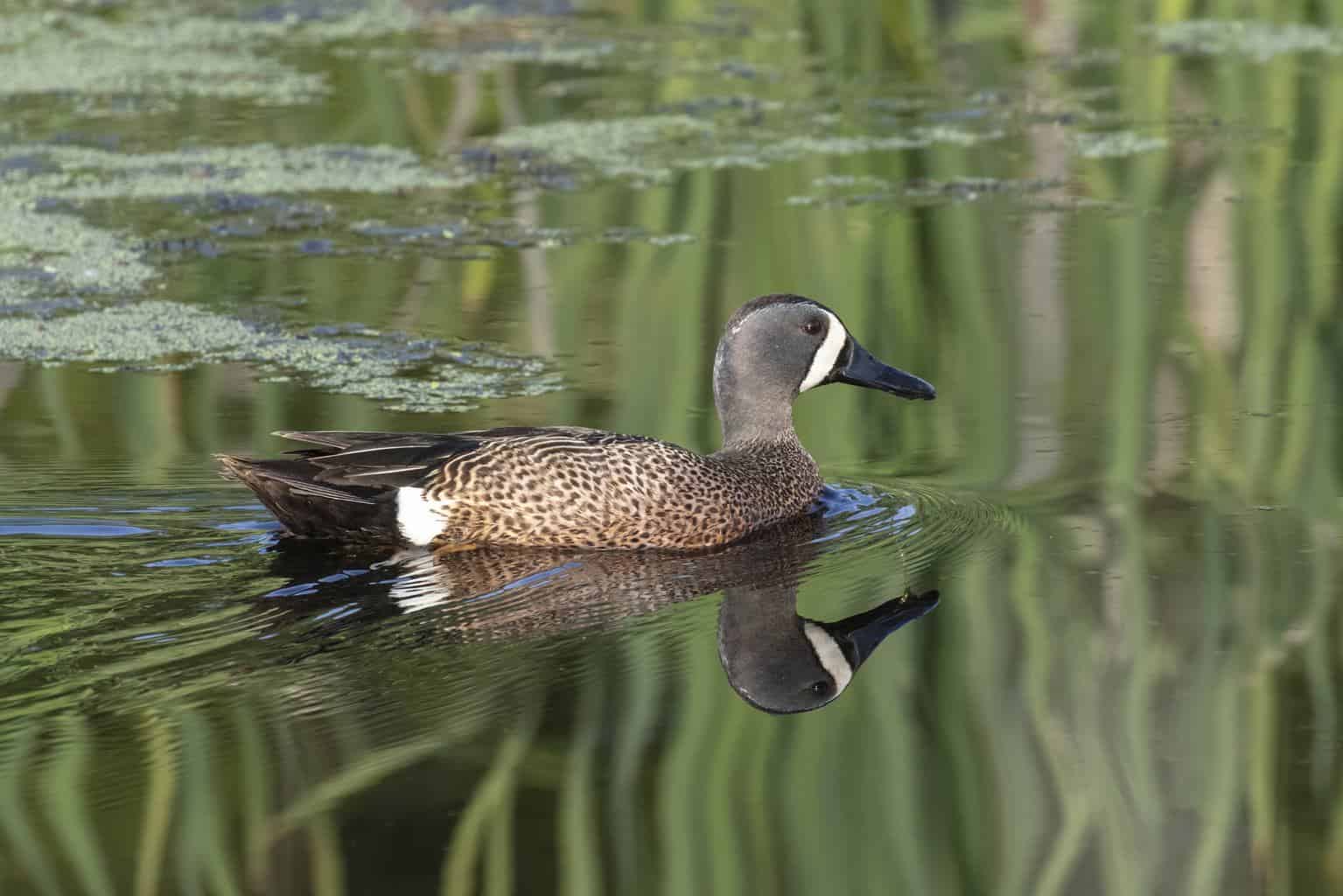
- Scientific Name: Spatula discors
- Length: About 16 inches
- Weight: About 13 ounces
- Wingspan: About 23 inches
Finding the Blue-Winged Teal is a nice surprise for every birdwatcher because it’s not one of the common birds in Hawaii. This dabbling duck can be found in freshwater, brackish areas, and saltwater marshes, where it uses rocks or tree trunks for resting.
The male bird has a rather big bill, buff-colored body with black spots and a blue head, while the female birds have coarsely spotted buff bodies. The Blue-Winged Teal feeds on aquatic plants and insects and prefers to feed on the surface of the water.
Hawaiian bird diversity has suffered recently because of so many invasive carnivorous species of animals. The wide variety of predators of the Blue-Winged Teal includes humans, snakes, snapping turtles, dogs, and cats, and it’s known to migrate for long distances. Their nest is usually covered with heavy vegetation.
Belted Kingfisher

- Scientific Name: Megaceryle alcyon
- Length: Between 11 and 14 inches
- Weight: Between 4 and 6.3 ounces
- Wingspan: Between 19 and 23 inches
Belted Kingfishers have blue-gray bodies with white spots on the wings and tail. Female birds have a chestnut spot on the belly. This bird spends most of its time perching along the edges of water bodies or hovering over them.
This bird feeds on fish, crustaceans, amphibians, and small mammals. It dives into the water with its eyes closed and swallows the prey whole.
Young birds have acidic stomachs that allow them to digest fish skeletons, but by the time they leave the nest, they regurgitate pellets that scientists can study.
Barn Swallow

- Scientific Name: Hirundo rustica
- Length: Between 6.7 and 7.5 inches
- Weight: Between 0.56 and 0.78 ounces
- Wingspan: Between 12.6 and 13.6 inches
The Barn Swallow is a stocky bird with a cobalt blue above and tawny below. It flies near the ground or water and can be seen perched on wires. This bird usually builds its cup-shaped mud nest on artificial structures.
It’s not attracted to suet feeders but will build a nest in your backyard if you leave a door or window open.
The bird mainly feeds on flies, bees, beetles, and wasps. An unmated Barn Swallow might kill the nestlings to have an opportunity to mate with the female.
Green Birds in Hawaii
Warbling White-Eye

- Scientific Name: Zosterops japonicus
- Length: Between 4 and 4.5 inches
- Weight: Between 0.35 and 0.45 ounces
- Wingspan: About 2.76 inches
Also known as the Japanese White-Eye, this bird is olive green on the back with a yellow throat and green forehead. The dark wings are outlined with green, and the distinctive white ring that surrounds the eye gives this bird its name.
It was introduced to O’ahu Island as a pet and pest control in the early 20th century but can now be found on every island. This bird is sociable and usually flies in flocks with other species.
The Warbling White-Eye feeds on flowering plants, insects, and nectar. Small mammals like rats are the most dangerous predators of this bird. It’s one of the common birds that you can find in your backyard or your fruit tree.
Red-Crowned Amazon

- Scientific Name: Amazona viridigenalis
- Length: Between 11 and 13 inches
- Weight: About 9.5 ounces
- Wingspan: Between 15 and 16 inches
The Red-Crowned Amazon or Green-Cheeked Amazon is an endangered parrot native to Mexico but first seen on O’ahu island during the 1960s. It has green plumage with a bright red forehead and dark blue streaks around the eyes.
You can see it flying in flocks in the morning or evening, and the birds are noisiest when they’re flying to a new food source. The Red-Crowned Amazon feeds on seeds, flowers, fruit, and nectar.
In the wild, these birds mate for life and usually form colonies with other group members by finding tree cavities to live in. The birds will return to the same tree cavities year after year. The Red-Crowned Amazon is known to copy voices and sounds.
Yellow Birds in Hawaii
Saffron Finch

- Scientific Name: Sicalis faveola
- Length: Between 5.5 and 6 inches
- Weight: About 0.7 ounces
- Wingspan: Between 8 and 10 inches
The male Saffron Finch has bright yellow plumage, while the female is slightly paler. It can be seen near houses and might build its nests under roofs. Males usually mate with two females and become territorial during the breeding season.
The Saffron Finch feeds on grass seeds and larvae. If you want to attract a Saffron Finch to your backyard, you can set up a nesting box, as these birds aren’t great nest builders. Place an artificial plant to provide the birds with the privacy they need.
Western Meadowlark
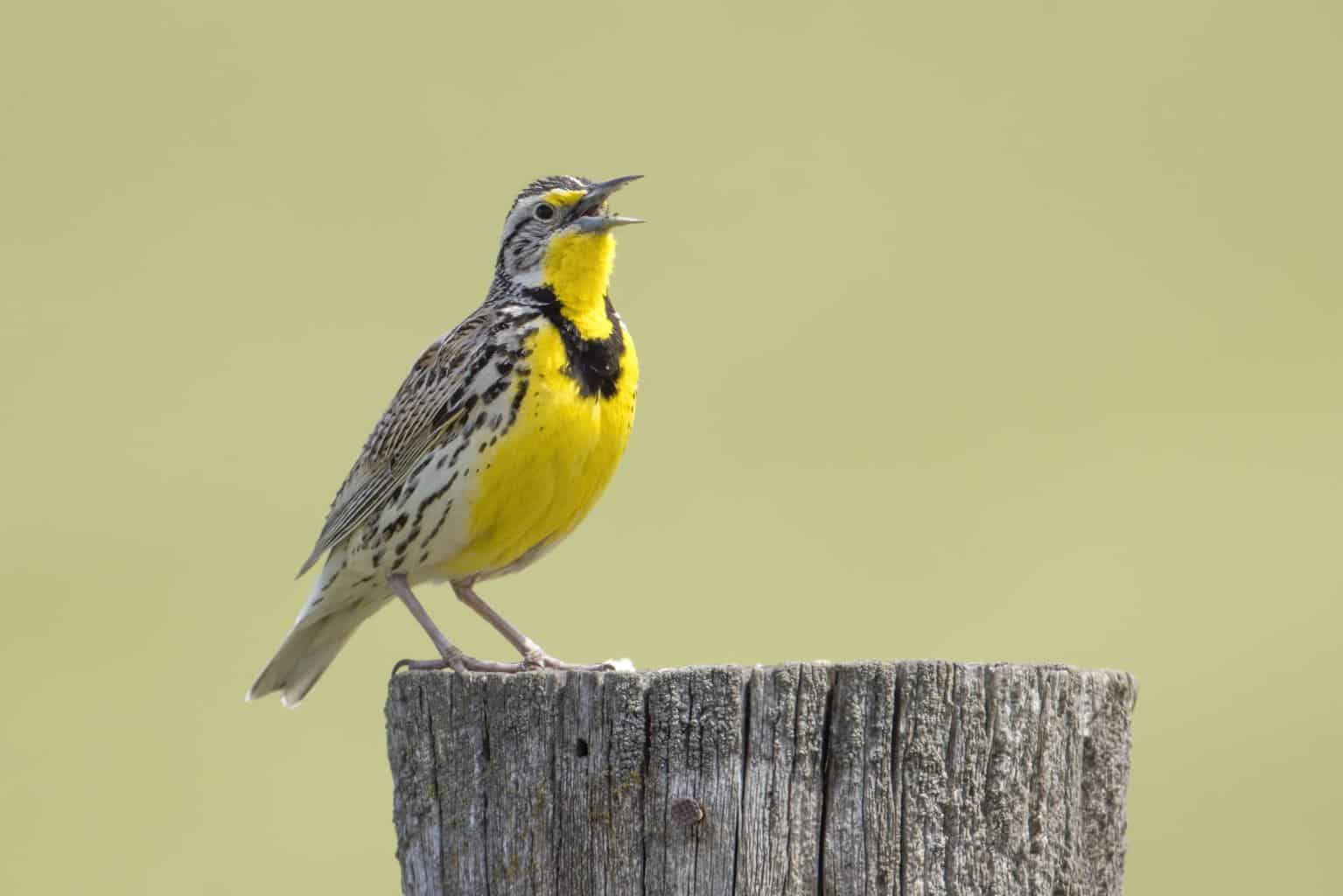
- Scientific Name: Sturnella neglecta
- Length: Between 6.3 and 10.2 inches
- Weight: Between 3.1 and 4.1 ounces
- Wingspan: About 16.1 inches
The Western Meadowlark has a bright yellow breast with a black “V” mark and a patterned upper. It usually flies low and can be found in mountain meadows at high elevations.
This bird is usually easier to be heard than seen, as it has a pleasant, distinctive song. It avoids heavily vegetated areas and usually feeds on seeds and insects.
You can see this grassland bird on the sides of the road or along marshes. You can attract the Western Meadowlark if you set up a feeding station in open habitat, as this bird isn’t regularly seen near backyard feeders.
‘Amakihi
- Scientific Name: Chlorodrepanis virens
- Length: About 3.9 inches
- Weight: About 0.45 ounces
- Wingspan: Between 6.5 and 7.5 inches
The Hawaiian ‘Amakihi is one of the most common songbirds in Hawaii. It belongs to the family of Hawaiian Honeycreepers and hasn’t been affected by habitat changes like other members of its family.
Despite the small size, it has a loud song that you can hear from miles away. It feeds on insects, tree sap, nectar, and fruit.
Other Birds to Watch For in Hawaii
Nene
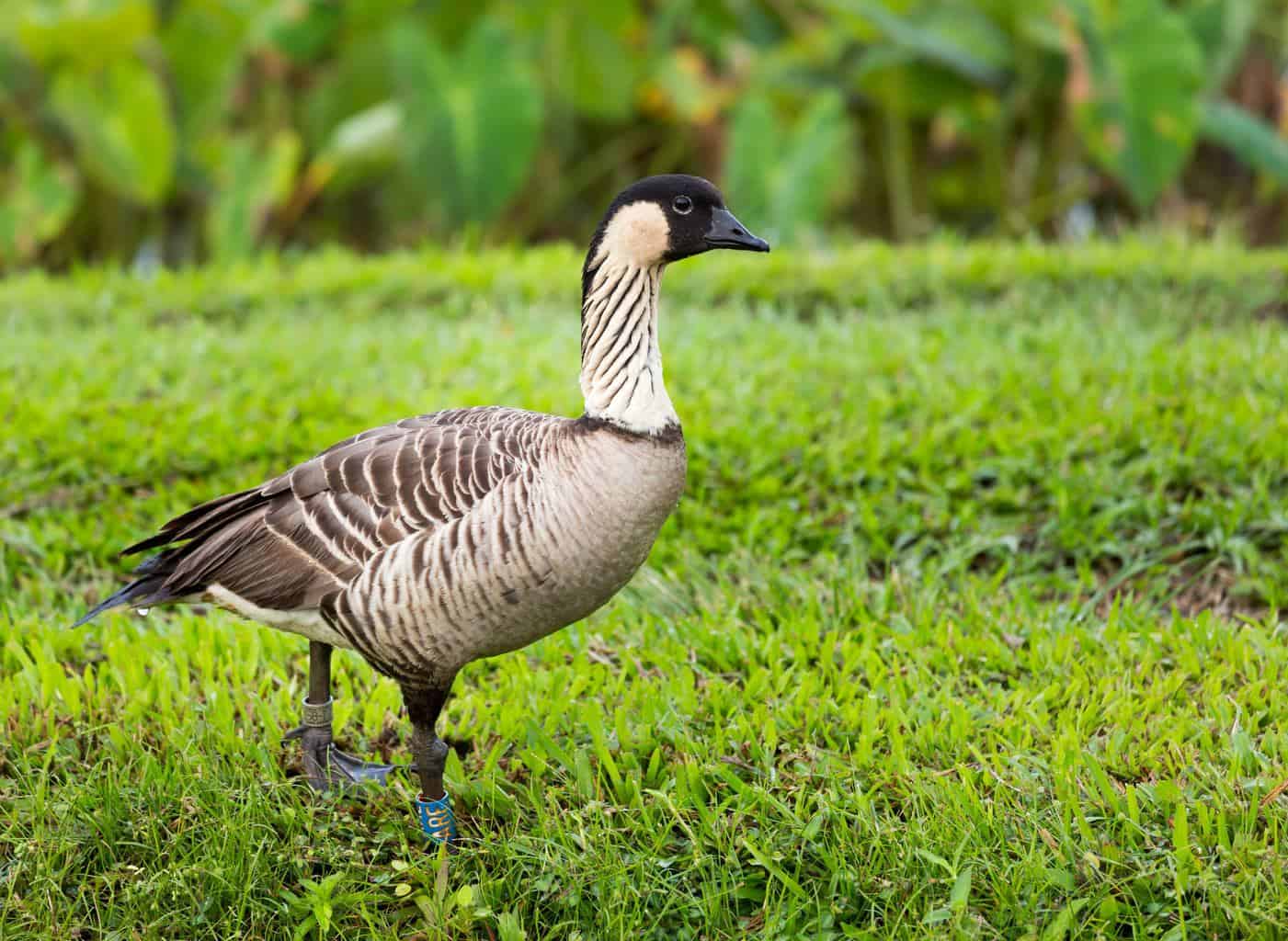
- Scientific Name: Branta sandvicensis
- Length: About 25 inches
- Weight: Between 3.36 and 6.72 pounds
- Wingspan: About 4 feet
The Nene or Hawaiian Goose is the official state bird of Hawaii. This bird has a black head, buff cheeks, and a heavily furrowed neck. The Nene Goose is mentioned in the Hawaiian creation chant, and the name comes from its gentle call.
With a population of about 2500 birds, the Nene is considered to be the rarest goose in the world. The birds mate on land, and the female builds the nest.
This bird is an inhabitant of lava plains, grassland, and coastal dunes, and today you can find it along the slopes of Kilauea and Mauna Kea in Hawaii Volcanoes National Park, where it likes to feed on ohelo berries. It also feeds on leaves, seeds, other fruit, and flowers.
Hawaiian Coot

- Scientific Name: Fulica alai
- Length: Between 13 and 16 inches
- Weight: About 1.9 pounds
- Wingspan: About 25 inches
The Hawaiian Coot is considered endangered by the State of Hawaii. This waterbird has a slate-gray body and a white beak and loves to live around freshwater lakes, marshes, coastal lagoons, and water storage areas.
The population of this bird declined drastically due to the loss of wetland habitats. It feeds on aquatic plants, invertebrates, and tadpoles.
Laysan Albatross

- Scientific Name: Phoebastria immutabilis
- Length: About 32 inches
- Weight: Between 4.2 and 9 pounds
- Wingspan: About 80 inches
The black and white Laysan Albatross is the second most common seabird in Hawaii. These impressive birds can fly through wild storms but often have trouble taking off when the wind is calm. This bird’s largest breeding colony is found on the Island of Laysan.
The Laysan Albatross sits on the surface of the water and catches the prey close to the surface. It feeds on squid, fish, fish eggs, and crustaceans.
Female birds are known to form bonds with each other while carrying for their young. These birds can live for more than 60 years.
Bonin Petrel
- Scientific Name: Pterodroma hypoleuca
- Length: About 11 inches
- Weight: About 6 ounces
- Wingspan: About 26 inches
This small seabird has a white head with black face markings and dark gray underpants. More than 99% of this bird’s population breeds on the Northwestern Hawaiian Islands, while only 1% breed off the coast of Japan.
The Bonin Petrel is a nocturnal feeder that catches fish and squid while resting on the sea surface or while flying. You can find most birds in multi-species flocks on land.
Introduced species like black rats represent a significant threat as they feed on the eggs of the Bonin Petrel, while rabbits destroy the bird’s nesting habitat.
Hawaiian Hawk
- Scientific Name: Buteo solitarius
- Length: Between 16 and 18 inches
- Weight: Between 15.6 and 21.3 ounces
- Wingspan: Between 34.2 and 39.7 inches
This brown bird is one of the two native birds of prey that you can find in Hawaii. There are two morphs of this hawk; the birds have light to dark brown bodies, with cream or dark gray below.
The Hawaiian Hawk or ʻIo is the royal symbol of the Hawaiian Legend. Due to its small range, this hawk is listed as near threatened. Traditionally this hawk fed on flightless birds, but today it feeds on lizards, rats, game birds, and insects.
Illegal shooting and vehicle collisions represent the biggest threats to the Hawaiian Hawks. The bird hunts from a stationary position or dives to catch the prey.
White-Rumped Shama

- Scientific Name: Copsychus malabaricus
- Length: Between 9 and 11 inches
- Weight: Between 1 and 1.2 ounces
- Wingspan: Between 10.5 and 11.5 inches
Male birds are glossy black with a chestnut belly, while female birds are shorter and more grayish-brown. The White-rumped Shama has a long tail that enables it to change direction quickly.
It feeds on insects, earthworms, and fruit, but it can be fed boiled legumes and egg yolk when kept as a pet. The White-rumped Shama is a territorial bird, and birds with longer tails are more territorial.
The bird usually uses leaves, grass, and twigs to build its nest between 6 and 20 feet above ground level.
Red-Tailed Tropicbird

- Scientific Name: Phaethon rubricauda
- Length: Between 37 and 41 inches
- Weight: About 30 ounces
- Wingspan: Between 44 and 47 inches
The Red-Tailed Tropicbird is a white seabird with a black mask and red bill. It feeds on flying fish and squid by plunge-diving into the water. Rats and feral cats feed on the eggs and represent a great threat to the young birds at nesting sites.
This bird is a strong flyer but walks with difficulty on land. A male bird with a long tail streamer is more attractive, and the female bird usually lays one egg. They range across the Pacific Ocean from Hawaii to Easter Island.
Zebra Dove
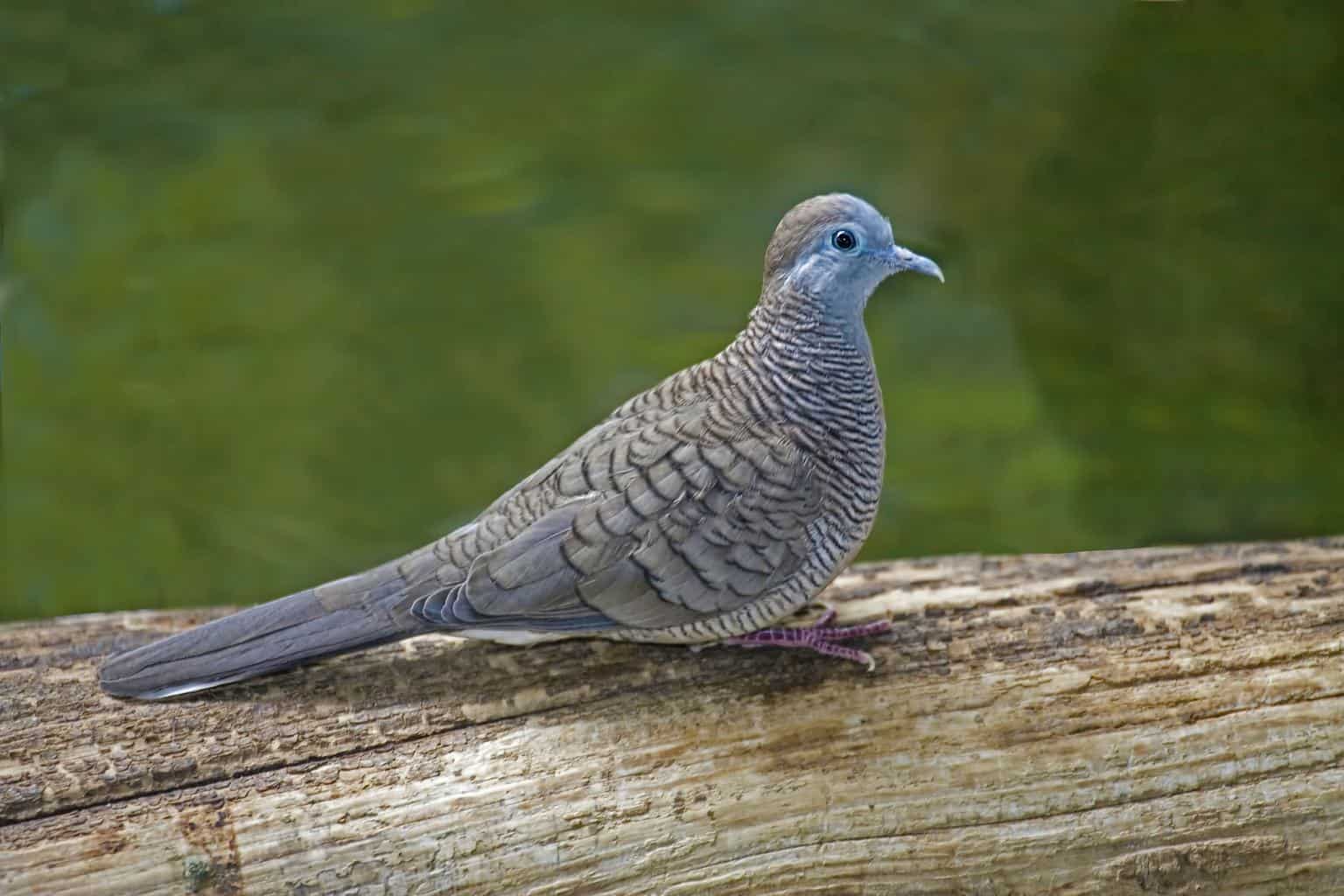
- Scientific Name: Geopelia striata
- Length: Between 7.8 and 9 inches
- Weight: About 2 ounces
- Wingspan: About 10 inches
The Zebra Dove is widely spread in Hawaii and represents a major concern in airfields. This small bird has a brownish-gray body with white and black barrings. It has a soft call and can be seen in gardens or parks and approaches people sitting in diners.
This dove feeds on weed and grass seeds, insects, and small invertebrates. The Zebra Dove prefers to forage alone or in pairs on bare ground.
Common Myna

- Scientific Name: Acridotheres tristis
- Length: Between 9 and 9.8 inches
- Weight: Between 4.5 and 5 ounces
- Wingspan: About 18 inches
The Common Myna has a brownish body with a distinctive yellow patch around the eyes. These birds are usually seen in pairs, strutting across the ground. This bird was introduced in 1856 to control armyworms.
Today, it’s quite common in Hawaii but is known to carry avian malaria and other parasites. In addition, it’s considered an invasive species and an agricultural pest because it causes considerable damage to ripening fruit.
It feeds on insects, crustaceans, reptiles, small mammals, grains, and discarded human waste. Common Mynas pair for life and build their nests using twigs, rubbish, tin foil, and sloughed-off snakeskin. The nests block gutters and water pipes in buildings. They’re also often found roosting in banyan trees.
Conclusion
Due to its unique nature, the Hawaiian island chain includes several rich habitats for various special birds that are nowhere else to be found. It’s recommended to focus on a single island to study its different species. Bring your bird guide and prepare to spend a lot of time traveling between islands chasing down one desirable bird after another.

